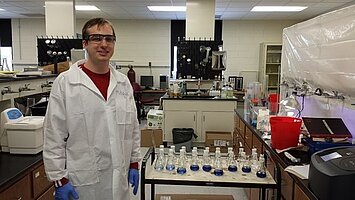The Role of Algal Species on Phosphorus Bioavailability

Mitchell Swanson is a Master of Science student in the Environmental Engineering Program at North Dakota State University. He holds a Bachelor of Science in Civil Engineering from North Dakota State University and an Associates of Liberal Arts degree from North Hennepin Community College. He was involved in undergraduate research concerning the removal of biodegradable dissolved organic nitrogen through ultrafilter and reverse osmosis membrane treatment. His current research is focused on bioavailable phosphorus from secondary effluents when examined with multiple algal species.
Email: Mitchell.Swanson@my.ndsu.edu
Phone: (612) 386-3857
Fellow: Mitchell Swanson
Advisor: Eakalak Khan, Ph.D., P.E., Professor, Department of Civil and Environmental Engineering, North Dakota State University
Degree Progress: M.S. in Environmental Engineering expected graduation in spring 2015.
The Role of Algal Species on Phosphorus Bioavailability
Eutrophication of waters is one of the major issues society faces, it degrades water quality and can lead to dead zones such as in the Gulf of Mexico. Phosphorus is one of the key nutrients that lead to eutrophication when sufficient concentrations are present in water bodies. However it is the bioavailable phosphorus (BAP) that is of real concern, because this is the phosphorus algae use to grow. S. capricornutum has been the standard algal species utilized to estimate BAP. This study will utilize two additional species, C. vulgaris and C. reinhardtii, for the comparison of BAP estimates.
It is hypothesized that BAP differs between different algal species as organisms fill different niches in ecosystems. There is little research concerning BAP especially in the area of environmental engineering. This research will further our understanding of phosphorus and how it is utilized by algae after being discharged and can impact how future nutrient standards are managed.
Project Objectives:
The main objective of this study is to investigate phosphorus bioavailability when examined from multiple algal species. The following objectives have been developed:
- Determine BAP from three different species when present individually and as a group. (In Progress)
- Analyze P-species distribution before and after bioavailability assays. (In Progress)
- Investigate the effect of enzymatic activity on BAP. (To be Completed)
- Evaluate the effect of pretreatment of samples with UV radiation on BAP. (To be Completed)
Progress:
Methods to measure the different phosphorus fractions have been determined and standards curves replicated successfully. Various methods of measuring algal growth for the determination of BAP have been explored and a method selected. Standard curves comparing algal growth to BAP will be created shortly. Samples incubated with the mixed algal inoculum will be examined through a microscope at the end of the incubation period in order to determine algal species ratios and to determine which algal species compete for nutrients more efficiently. After the replication of standard curves for algal growth and therefore BAP, secondary effluent samples will begin to be examined.
Significance:
Results will show whether BAP estimates vary between different algal species. If results vary this research will show that the current standard algal species of S. capricornutum is not necessarily a reliable estimate of BAP and that other algal species may provide a higher estimate of BAP. The research will also show how the algal species affect the concentration of the different P-species from multiple WWTP effluents.
The effects of enzymes and UV light on P-species and their potential to convert non-BAP to BAP will also be determined. This provides further understanding on how algae and other physical factors are converting the P-species into usable forms that can be taken up by algae.
Related Publications:
Kasi, M., Simsek, H., Swanson, M., Ahlschlager, S., Ritterman, K., Hausauer, J., Hoff, J., and Khan, E. (2013) Total Nitrogen Removal by Reverse Osmosis: Role of Biodegradable Dissolved Organic Nitrogen. In Proceeding 86th Annual Water Environment Federation Technical Exposition and Conference, Oct. 5-9, 2013, Chicago, IL, Water Environment Federation.

Eakalak Khan
Civil & Environmental Engineering
NDSU


